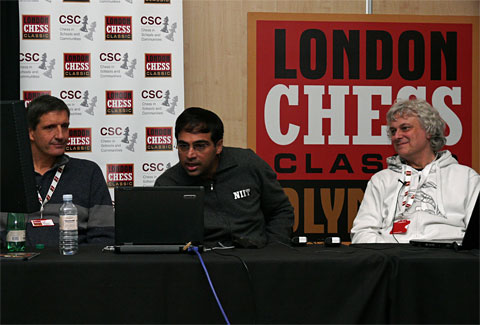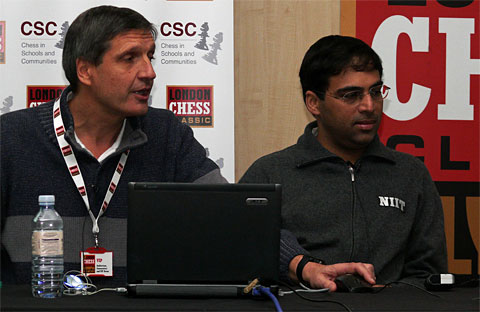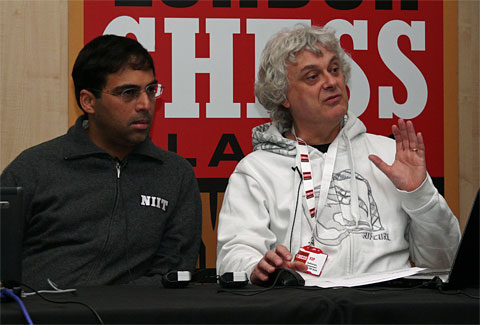
Astronomy at the London Chess Classic
Lecture by Vishy Anand, John Nunn and Dr Christian Sasse
Wednesday 7th December, 7:00 p.m. in the commentary room – visitors gathered in anticipation of a special trip to the edge of the galaxy and beyond, with a group of chess-playing amateur astronomers. First Grandmaster Dr John Nunn showed and talked about some of his award-winning astronomical images, taking us through star clusters, stellar nurseries, supernova remnants and on across millions of light-years to distant galaxies.
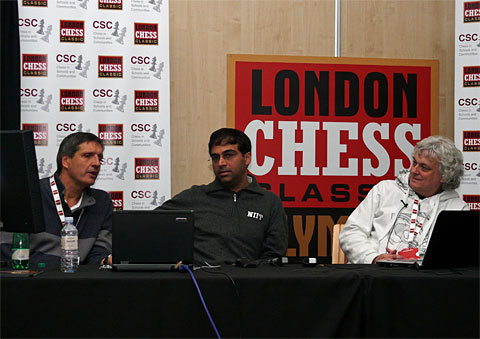
Dr Christian Sasse, Vishy Anand, John Nunn at the astronomy session
Then Dr Christian Sasse from Vancouver explained the technology behind these remarkable images and show how, thanks to the Internet, it is possible to control telescopes on the other side of the world in real time. Finally World Champion Vishy Anand gave us a hands-on demonstration, operating a telescope in Spain (the ones in Australia and the US were in daylight). Anand used the scope to capture a giant image of the Andromeda Galaxy M31.
For the vast majority of our readers who could not be in London Wednesday night to attend the lecture there is good news. It was all streamed on the Internet by Macauley Peterson and archived on the tournament web site for you to watch. The entire session is ninety minutes long, but well worth watching – it was at least as interesting, one spectator said, as one of the chess rounds of the Classic.
Click on the little TV set icon on the bottom right for a full-screen viewing of the lecture
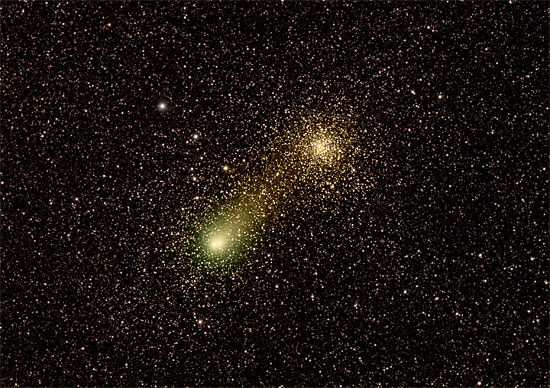
This is a remarkable image captured by Anand: comet Garradd passing the globular cluster M71
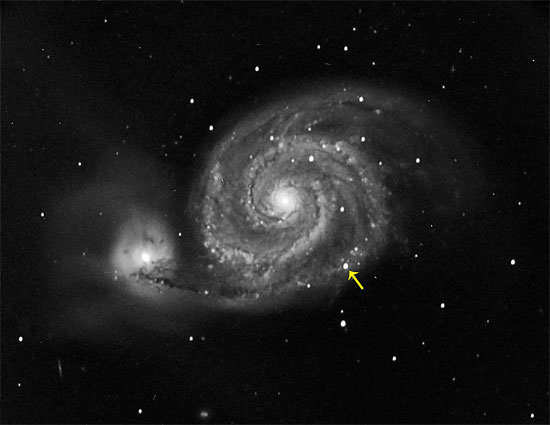
This is an image that made us positively jealous: in June this year Anand captured a supernova in the Whirlpool Galaxy (M51). The first hint of the explosion came on May 31st, when French amateur Amédée Riou noticed a previously absent 14th-magnitude star in a CCD image of the galaxy with his brand-new 14-inch reflector. Astronomers determined that this was a Type II supernova, which is the explosion of a single massive star whose core has abruptly collapsed. You will see that the supernova is missing on the image taken by John Nunn below.
How far (back) can we see?
German-Canadian physicist-engineer Christian Sasse, seen above with Vishy Anand, recently embarked on a project to set up a new star machine that he felt certain would allow ‘amateurs’ to peer back in time, to galaxies far, far away. Actually to a certain quasar in Ursa Major, powered by a supermassive black hole three billion times the mass of our Sun. This monster roared into existence with brutal cosmic power only 870 million years after the universe began. It sends out infrared luminosity over 22 trillion times brighter than our own mediocre star, forming a huge bubble of carbon monoxide molecules 30 million light-years in diameter around its host galaxy.
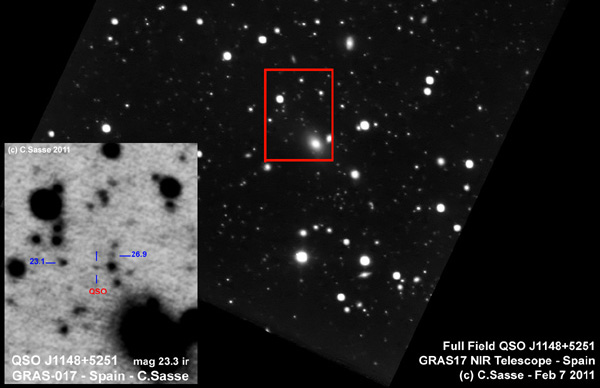
Last year Christian pointed the newly commissioned G17 Deep Red Telescope based at the GRAS-Astrocamp facility in Spain, to an otherwise blank piece of sky. G17 proceeded to capture a few hundred thousand ancient photons on its CCD camera during 16 hours of exposures (199 x 300 secs). The first signs of the quasar appeared after about two hours of exposure.
John Nunn's astronomical collection
For those of you who do not have the time to watch the presentation, and for those who would like to view John Nunn's astronomical photography in all its visual glory, here are some of the images he presented. Many of them have been published on our pages before. In each case you can click on the image to get a much larger version – though of course not anywhere near the multi-megapixel originals that John has produced.

This is the Pleiades (or M45), an open star cluster in the Milky Way about 440 light-years away which is sometimes called the ‘Seven Sisters’. It’s visible to the naked eye, but the blue cloud surrounding the stars can only be seen in long-exposure photographs. At one time it was believed that the stars in the Pleiades were formed from this cloud, but more recent observations indicate that the stars are just passing through a random dust cloud.
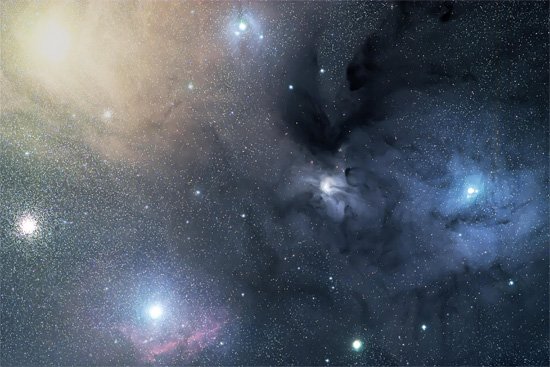
Rho Ophiuchus Nebula: Distance 460 light-years. The bright reddish star to top left is Antares. The globular cluster just below and to the right is NGC 6144. The globular cluster at lower left is M4 (7,200 ly). The swirling dark nebula near the top, middle to right, is Barnard 42 (or part of it, in any case). The various connected bright reflection nebulae in the centre, mid-right and top-centre are IC 4603, IC 4604 and IC 4605. The bright triple star at mid-right is Rho Oph. The red nebula to lower left below the bright star Sigma Sco is Sharpless 9.
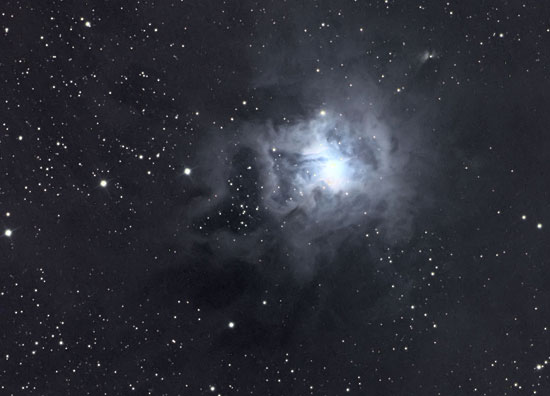
The Iris Nebula lies about 1,300 light-years away in the constellation of Cepheus. It consists of a cloud of dust and gas illuminated from within by a bright star. It appears blue because the dust in the cloud, which is about six light-years across, scatters blue light better than other wavelengths (a similar process creates the blue sky on Earth).
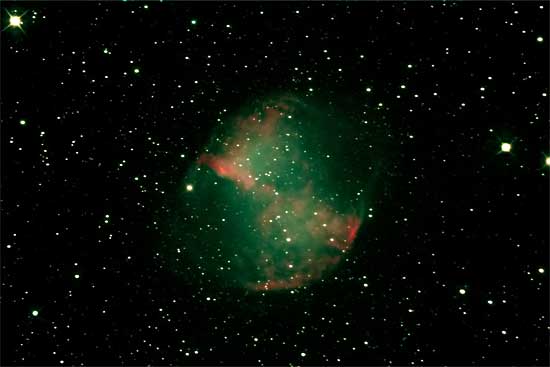
Dumbbell Nebula: Distance 1,350 light-years. About 10,000 years old and two light years across. The central star is white dwarf of about 0.5 solar masses. It is the first planetary nebula ever discovered (in 1764). The green colour is due to oxygen, the red glow is nitrogen.
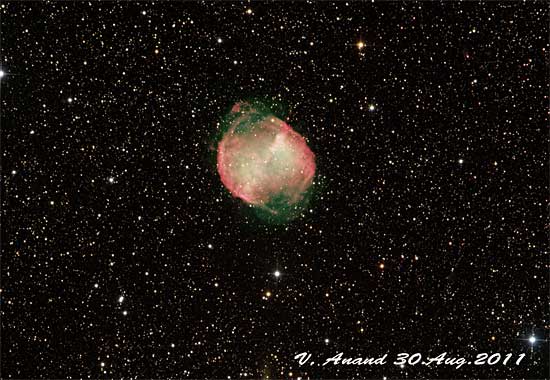
A different view of Dumbbell taken by a different grandmaster with a different telescope.

The famous Orion Nebula, one of the few nebulae visible to the naked eye. It’s about 1,350 light-years from Earth and is part of much larger structure, called the Orion Molecular Cloud Complex (which includes the Horsehead Nebula and the Flame Nebula). Stars are forming within the whole complex but it’s especially obvious in the Orion Nebula, in which about 700 stars are forming.
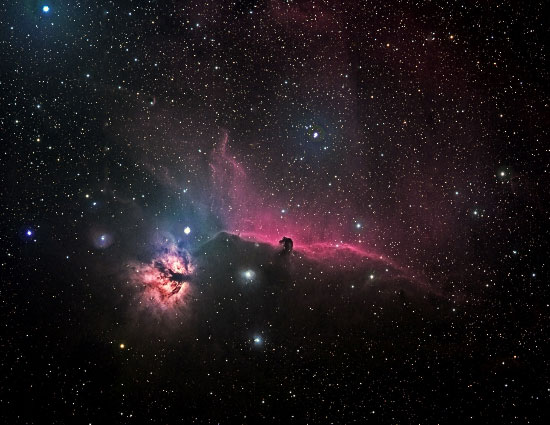
The Horsehead Nebula is part of the much larger Orion Molecular Cloud Complex, which was used on the cover of Nunn's Chess Endings Vol. 2. It is approximately 1500 light years from Earth. It is one of the most identifiable nebulae because of the shape of its swirling cloud of dark dust and gases, which is similar to that of a horse's head when viewed from Earth.
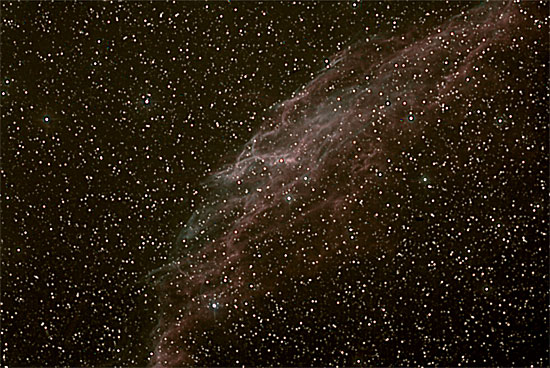
NGC 6992, known as the Eastern Veil Nebula, part of the remnants of a supernova that exploded some 5,000 to 8,000 years ago. It was probably familiar to human observers, and when it detonated it was visible in broad daylight. The remnants were discovered in 1784 by William Herschel.
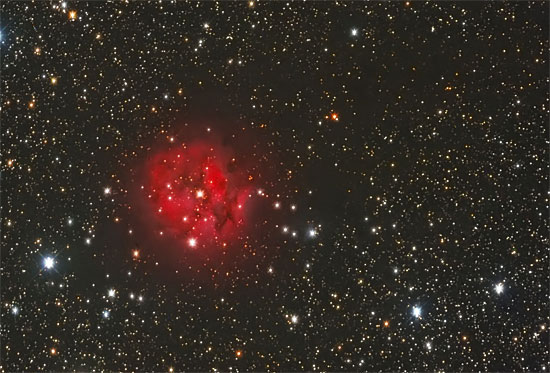
Cocoon Nebula, 3300 light years distant, is part emission, part reflection. The central star formed about 100,000 years ago, and the nebula is about 15 light years in diameter. There is a dark nebula that leads off to upper right.
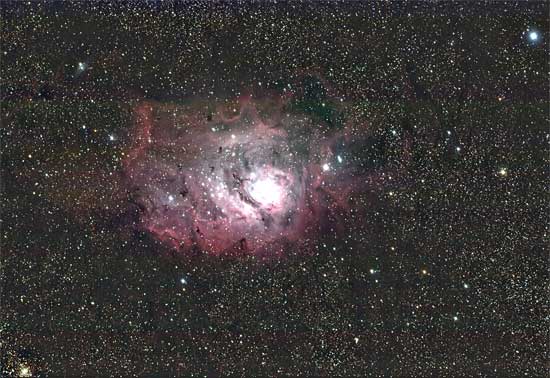
The Lagoon Nebula (click to enlarge) is a giant interstellar cloud in the constellation Sagittarius. It was discovered in 1747 and is one of only two star-forming nebulae faintly visible to the naked eye from mid-northern latitudes. Seen with binoculars, it appears as a distinct oval cloudlike patch with a definite core. The Lagoon is between 4,000 and 6,000 light years from the Earth and is one of Vishy Anand's favourite star-forming nebulae.
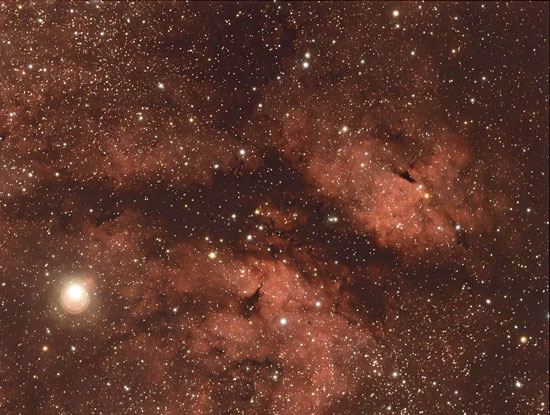
The above image shows part of the Gamma Cygni nebula, which is a huge area of nebulosity in the direction of the bright star Gamma Cygni (also known as Sadr). Gamma Cygni, the bright star to lower left in this image, is only 1,500 light-years away, and so cannot be physically connected to the nebula, which lies at twice the distance. The nebula is a huge gas cloud and it is emitting the pinkish light typical of excited hydrogen gas.

The Trifid Nebula, an unusual combination of an open cluster of stars, an emission nebula (the upper, red portion), a reflection nebula (the lower portion) and a dark nebula (the apparent dark arms within the red part of the nebula). It’s about 7,600 light-years from Earth.

This image was a combined effort between myself and Dr Christian Sasse. The Crab Nebula is probably the most famous supernova remnant. The distance isn’t known very accurately, but estimates range around the figure of 6,500 light-years. The Crab Nebula is the result of a supernova explosion which was recorded by Chinese and Arab astronomers in 1054; it’s currently about 11 light-years across and is expanding at about 1,500 kilometres per second. The star that exploded almost 1,000 years ago afterwards collapsed to form a neutron star, that is a star in which intense gravitational pressure has caused its atoms to collapse, leaving only a mass of tightly-packed neutrons. The Crab neutron star rotates rapidly, and emits a beam of radiation (including visible light) which sweeps across our solar system 30 times a second, so that it appears to be flashing very rapidly. Of course, you can’t see this effect on a long-exposure photograph which averages the light received during the exposure. Neutron stars which exhibit this behaviour are called pulsars and if you want to identify it in the image, look for two stars very close together at the centre of the nebula. The pulsar is the fainter of these two (the one at the lower right). We would like to remind you that such supernova explosions create iron, and element which we need to be able to absorb oxygen. Each molecule of haemoglobin in our blood contains four iron atoms, and these atoms were all once part of the core of a large star.
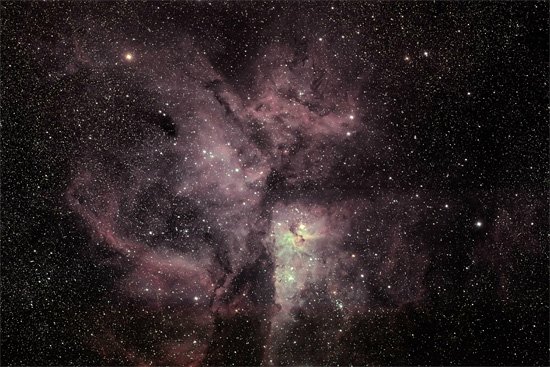
This is the Carina Nebula, a Southern hemisphere object. It’s a cloud of dust and gas surrounding a cluster of bright starts. One of these, Eta Carinae (near the brightest part of the nebula), is a hypergiant star with about 100-150 times the mass of the Sun, which is near the theoretical maximum mass for a star – any larger and the star would explode immediately. It is four million times as luminous as the Sun and is very unstable – indeed it could explode in a supernova at any time. Fortunately, it’s a safe distance from us – about 8,000 light years.

This object is Omega Centauri. Our Milky Way galaxy is surrounded by about 150 so-called globular clusters, each of which is a densely packed balls of stars in orbit about the Milky Way. Globular clusters contain almost exclusively very old stars so they have clearly been around for some time, although how they arose is uncertain. Some astronomers speculate that Omega Centauri, which is different in many ways to other globular clusters, may be the core of dwarf galaxy whose outer layers have been absorbed by the Milky Way.

The Milky Way has two sizeable companion dwarf galaxies, the Large and Small Magellanic Clouds, which are only visible from the Southern Hemisphere. The above image is of the Large Magellanic Cloud, which is about 160,000 light-years away from us and about 14,000 light-years across. With a mass of 10 billion times the mass of our Sun, it has about one-tenth the mass of the Milky Way. To the right of the image, slightly below the centre, you can see the Tarantula Nebula, which is the largest star-forming region within several million light-years of Earth.

The Tarantula Nebula is such an interesting object that I decided to take a closer look with a different telescope. It is 500 light-years in diameter and the most active star-forming region in any nearby galaxy.

Here is one of the most magnificent objects in the sky, M31, the Andromeda Galaxy. This is the nearest large galaxy to the Milky Way and is ‘only’ 2.5 million light-years distant. It is a bit larger than the Milky Way, and contains roughly a trillion stars, significantly more than our galaxy. However, astronomers are undecided as to which of the two galaxies is the more massive, since the Milky Way appears to contain more dark matter than Andromeda. It is apparently visible to the naked eye in perfect conditions (although I have never managed to spot it) and can be seen with binoculars even in light-polluted urban conditions. I like this image, which provides a good view of Andromeda’s spiral arms, and its two satellite galaxies, M32 and M110. The Andromeda Galaxy is approaching our Milky Way, with the collision expected in three billion years. Click on the image above to retrieve a 1920 x 1200 version of the Andromeda Galaxy that you can use as a desktop background on high resolution monitors.
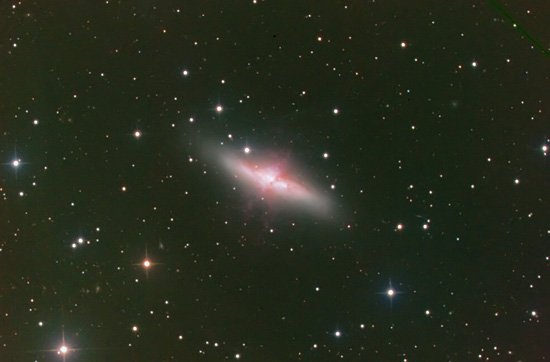
Object 3 – click to enlarge
This is the starburst galaxy M82 (also called the Cigar Galaxy), about 12 million light-year away. Tidal forces caused by the gravity of the nearby massive galaxy M81 have deformed this galaxy, a process that started about 100 million years ago. This interaction has caused star formation to increase tenfold compared to ‘normal’ galaxies.

The galaxy M101 in Ursa Major is often called the Pinwheel Galaxy. It's about 21 million light years away and is approximately twice the size of our own Milky Way galaxy. Spiral galaxies vary greatly in appearance according to the angle at which we are viewing them. M101 appears almost face-on, which gives us the chance to appreciate its spiral arms and the large number of star-forming regions, which appear bluish in colour.
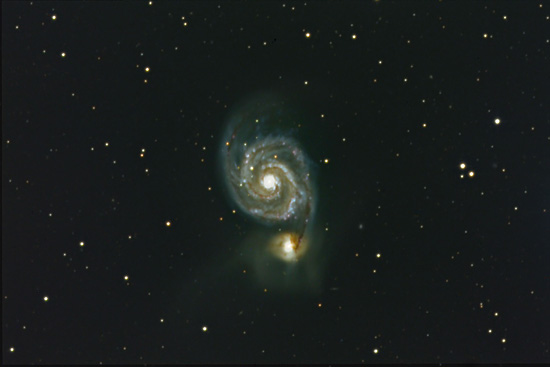
The Whirlpool Galaxy (or M51) is a galaxy about 23 million light-years away. Together with its companion (NGC 5195) it can be seen with binoculars and it’s a favourite target for both amateur and professional astronomers.

M106 is a Seyfert galaxy about 23.5 million light-years from Earth. Unusual radio emissions indicate that it has a black hole of about 30 million solar masses at its centre. The spiral arms of M106 are also rather odd, presenting a mystery which has only recently been solved. Just below and to the left of M106 is NGC4248, a smaller galxy which is a similar distance away and is probably gravitationally linked to M106. Several fainter (and much more distant) galaxies can be seen in this image. For example, directly above NGC4248 you can see an edge-on spiral galaxy. The distance to galaxies such as these cannot be determined directly, but it can be inferred from the galaxy's redshift (in this case it appears to be about 850 million light-years away).

Above is the image of two galaxies in the constellation Leo, M65 (on the left) and M66 (on the right). This pair represents two-thirds of the famous ‘Leo triplet’, but unfortunately the remaining one (NGC 3628) is too far away to lie in the field of view of the telescope he used, G11. In a GRAS article John has explained how to use deconvolution, a mathematical technique for removing blurring, in order to enhance the images that come out of the telescope, how to combine sub-frames to make a colour image, and how to use other techniques to achieve the perfection you see in the example above. Very instructive.
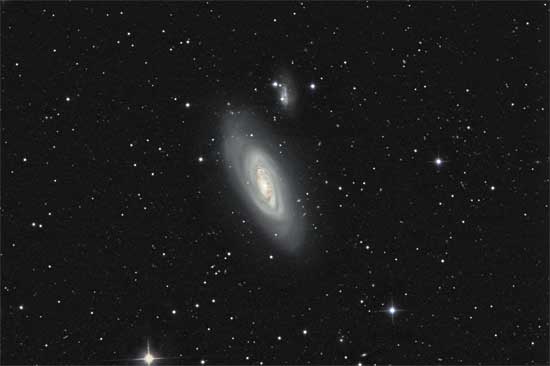
The outer reaches: Messier 90 (also known as M90 and NGC 4569) is a spiral galaxy about 60 million light-years away in the constellation Virgo. It was discovered by Charles Messier in 1781. M90 has a satellite irregular galaxy much like the Magellanic clouds.

Global Rent-a-Scope (GRAS) is a global network of remotely operated telescope systems. Subscribers connect to any of the available worldwide locations and take their own images. This publicly accessible time rental service is available through any Internet connection, including dial-up. The initial startup service began operations in 2001.
London Chess Classic
The games are being broadcast live on the official web site and on the chess server Playchess.com. If you are not a member you can download a free Playchess client and get immediate access. Or you can get our latest Fritz 13 program, which includes six months free premium membership to Playchess.
|
|




















